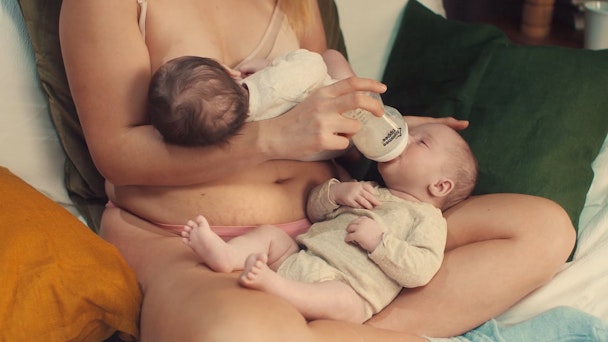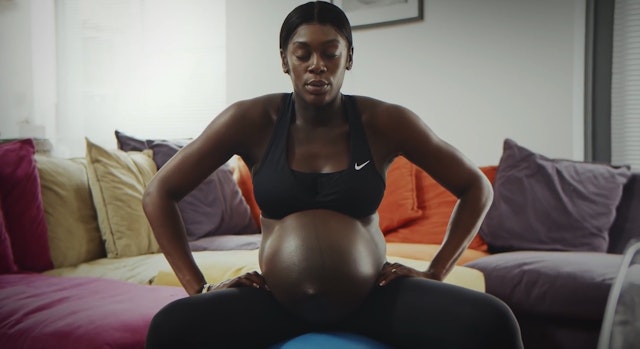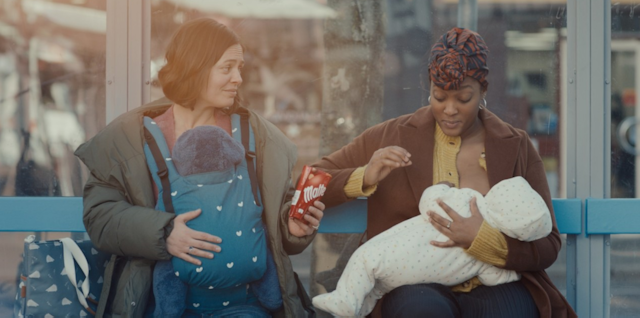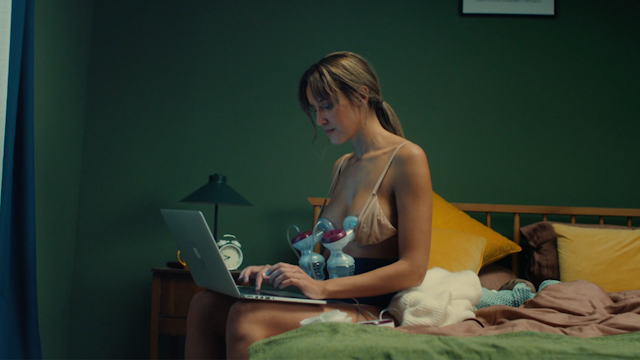
Advertisement

Tommee Tippee’s ads want to demystify the complex realities of feeding for moms, but they were banned by Facebook
From breastfeeding to post-partum bodies, maternal mental health to discrimination, 2021 has seen some bold brands finally reflect the realities of motherhood in their advertising. Now it’s time for others to follow suit and execute strategies that will strike the right tone to unlock this demographic’s spending power.
Ads centered around moms have a long history of sugar-coating motherhood.
While Mother’s Day cards lean on floral designs and garish poems to pay tribute, brands have often depicted Mom as the sole caregiver – the one whose responsibility it is to pick up the discarded bottles, bath baby, scrub stains out of their adventurous toddlers’ clothes and cook dinner.
However, 2021 has sparked a revolution in the way brands talk to moms.
Over the weekend, International Mother’s Day saw advertisers take a more thoughtful approach to the holiday. DTC care brand Billie (literally) put real post-partum bodies on a pedestal, while shoe company Saucony offered solidarity with moms in the ‘marathon that never ends’. Back in March, International Women’s Day saw Maltesers use comedy to break down taboos around maternal mental health. When the UK celebrated Mother’s Day, Nike paid tribute to the ‘toughest athletes’ with a campaign celebrating the strength of mothers timed to chime with the launch of its own maternity line.
“There has been a big shift in culture that is pushing back against the idea of the perfect mom,” says Polina Zabradskaya, who recently helped Maltesers steer a more open dialogue about the struggles faced by moms.
“Brands are largely responsible for creating that unrealistic motherhood myth, so it’s great to see some helping to burst the bubble.”

The step change in how companies are talking to mothers goes beyond dedicated holidays. Advertisers the world over are becoming more direct and realistic in their portrayals of day-to-day motherhood and, in particular, breastfeeding.
Cluster feedings, cold cabbage compresses and milk-engorged breasts featured in Frida’s first TV commercial during the Golden Globes in April. Elsewhere, British baby business Tommee Tippee was ahead of the curve in February with a global campaign designed to demystify the complex realities of breast feeding for new and prospective mums. DTC darling Elvie (the ‘Apple of women’s health’) has long distinguished between boobs and udders.
The spending power of moms has long been underestimated by brands, but data shows it would be foolish not to reconsider how they’re speaking to this essential demographic right now.
Moms are the chief influencers of all family purchases. In the UK, they account for over 70% of all household spending across all category types, representing a whopping £205bn of the UK’s total economy. In the US market, moms are the most coveted consumers, with their buying power topping $2.4tn annually. Again, they control or influence 85% of all household purchases.
However, for Siobhan Freegard OBE, founder of online parenting communities Netmums and Channel Mum, many feel left behind by brands. A study run by the latter finds that 93% of moms don’t think traditional advertising accurately represents their parenting experiences.

“It’s not enough simply to ‘feel seen’ anymore. Mums want to see equality, diversity and genuine inclusion of every type of mother, child and family set-up that differs from their own,” she explains.
She adds: “This isn’t just about marketing ‘at’ mums, it’s about engaging with them, listening and holding a dynamic, two-way conversation about their wants and needs too. It’s also about what brands can do to support families and give back.”
The first step for brands on this journey is using their creative to strike the right tone with not only moms, but women. Figures from the Geena Davis Institute on Gender in Media show that – despite industry-wide efforts to purge them – stereotypes are still rife in ads. Women are shown as being funny in just 3% of ads, with men almost twice as likely to use humor as a mechanism. Women are also 48% more likely to be shown in the kitchen than their male counterparts.
“With statistics like this, it’s unsurprising that many women still don’t feel their experiences or reality are well portrayed by the communications industry,” says AMV’s senior strategist Emily Brydon, who worked with Zabrodskaya and Matt Swinburne on the recent Maltesers ‘Massive Overshare’ mom mental health push.
With a heartland audience of women, this is something the Mars-owned brand has always tried to change, running tongue-in-cheek campaigns centered on the menopause and disability, underpinned by financial and charity supporting.
Brydon says as a starting point brands need to have an “extensive consultation process throughout both the strategic and creative development” if they want to speak to women, and moms, in an authentic way.
“Topics like maternal mental health are not openly discussed, and until they are the harrowing statistics that show it’s undetected and misunderstood won’t begin to change,” she says.

Jess Bird is strategist at Elvie’s creative agency, the aptly-named Mother. She agrees that despite the progress made in real and raw depictions of motherhood, agencies and clients need to start having conversations that go wider than moms and think more generally about how they speak to women.
“We’ve been thinking deeply about what tone brands should adopt, what assumptions they make and what power dynamic is established between brand and audience,” she says.
For a long time, she argues, brands have adopted the voice of an implicitly male authority that feels it has the right to tell women who they are or what they should be, which even extends into this latest wave of ‘fempowerment’ advertising.
Elvie, she says, doesn’t want to be the brand that swoops in to ‘fix’ or ‘save’ women.
“Women know who they are, or in the process of finding it out for themselves – it’s not up to anyone to dictate that experience, but to speak truthfully and offer something useful.”
She argues that, as an industry, it’s important adland pays women the respect they deserve. Elvie’s ads aim to recognize them as intelligent humans who appreciate wit, humor and creativity.
“We don’t want to trivialize or invalidate the experiences that women have with their bodies, but we want to surprise and entertain.”
If they are to build campaigns that moms can relate to, then chief marketers must ensure their teams are having real, honest conversations with mothers. To get these started, they need look no further than social media, where communities of moms are blossoming on platforms like Instagram, YouTube, Facebook and even TikTok.
Portals like Mother Pukka, Mumsnet and Channel Mum offer moms forums to discuss everything from perineal massage and birth stories, through to advice on parenting teens. This, coupled with the rise of the ‘momfluencer’ and communities built around topics like breastfeeding and post-partum bodies, are changing the marketing sphere for brands – not only as a research tool, but also a media buy.
“Over two thirds of UK mums follow influencers so – done well – it’s the most natural way to align your products with families,” says Freegard. “You’re not trying to shoehorn your ad into an online forum which might not be brand safe, nor hope a mum sees it on the side of a bus – instead you’re placing it where mums are actively choosing to go.”
When Tommee Tippee launched ‘The Boob Life’, an unapologetic celebration of real moms, their bodies and their choices, it wanted to push its first-ever breast pump and looked across the social media spectrum to see what moms were talking about online.
The brand found moms were having “vocal, emotional” conversations around breastfeeding but that many felt “left in the dark” – they’d never seen someone breastfeed on TV or on screen, just in medical books or on pamphlets.
“A lot of people talk about baby, and that is important, but moms got left behind in all the noise. We were hearing from women who said ‘I don’t want to labeled as Mom, I’m me, this is about my identity’. So that really started to shape where we went with this campaign,” explains Chomoi Picho-Owiny, creative director at Manifest, which led the work.
However, media still needs to catch up with creative on this front. Tomme Tippee’s campaign was banned from running on Facebook and YouTube in countries like the UK and Australia because it featured breastfeeding moms and ‘visible nipples’.
The brand circumvented this by running some content natively on platforms like Instagram (where it is deemed ‘appropriate’) but it showcases the challenges in building a media plan that feels inclusive for moms.

Manifest’s campaign director Emma Corbett is frustrated by the legacy in advertising that bans breastfeeding when it’s “one of the most natural things in the world”.
“There’s an entrenchment of the stigmas that need to get broken down for women to feel like they’re not unsupported, overlooked or underacknowledged,” she says, saying she hopes social media including Facebook reconsider their policies in this area.
Freegard runs an all-women agency at Channel Mum, offering brands consultation and guidance. For her, there’s still a distinct lack of mums in the decision-making and creative process, which is stalling progress.
“You wouldn’t advertise a car without driving it, but we’ve lost count of the number of times we’ve attended a meeting for a product aimed at families and not one person from the agency or brand has a child,” she says.
“With three quarters of mums now working, we hope this will change over time, with more mums given the place they deserve at the marketing top table.”